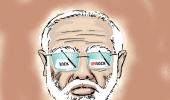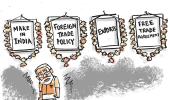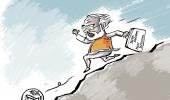'The most important thing to do is to stop taxing citizens so brutally,' recommends T C A Srinivasa-Raghavan.
Illustration: Dominic Xavier/Rediff.com

Now that practically every economy in the world is down on its knees, a question that was frequently asked 75 years ago, when the Second World War ended, is being asked again: How to get them back on their feet and trotting again?
It's not that hard a question, provided you remember two answers from back then.
If you don't -- and it is likely that you either don't or were never taught it -- here it is.
One is known as the Harrod-Domar model. The other is the Big push Theory.
The former is named after a British economist, Sir Roy Harrod, and Mr Evesy Domar, a Russian-American economist.
The latter is due to P N Rosenstein-Rodan, a Polish-American economist.
The Harrod-Domar model addressed itself to a political problem: How to maintain a high rate of employment? Remember, this was when Communism was all the ideological rage in Europe and used unemployment as fodder.
Rosenstein-Rodan, too, tried to provide an antidote to communism. His solution was called the Big Push Theory.
The Harrod-Domar answer was, in Clintonese, 'It's investment, stupid.'
The more an economy invests, the model said, the better off it would be in terms of expansion of output and employment.
Rosenstein-Rodan's Big Push theory said the same thing, but emphasised that achieving economic growth was like getting a plane off the ground.
Just as it needs a critical minimum speed, an economy also needs a critical minimum level of investment.
In both, the important thing was the term 'critical'.
China, South Korea, and other East Asian countries focused on that part.
India, obsessing over equity, focused on 'minimum'.
China has been investing around half of its GDP.
India invests not even half that. Look where China is. Look where we are.
So that's all there is to it, folks, investment.
Increase it and you are flying.
Decrease it and you are taxiing forever.
Import substitution
The question still remains, though: Invest, yes, but with or without tariff protection? India got it all wrong between 1957 and 1991, when it provided high tariff protection to a low-investment economy.
The result was economic disaster.
Then came the 1991 reforms, which undid this foolishness.
But over the next 20 years it overshot the tariff protection thing by lowering tariffs for everything far too much.
And, to make matters worse, it kept the rupee overvalued.
China did the opposite.
As a result, the Chinese moved in and Indian industry has got destroyed.
Manufacturing contributes less than 20 per cent to GDP.
This is what the Modi government has been trying to reverse, without much success so far, because of Mr Modi's mistaken dalliance with China.
But now that China has spurned his love, the atmanirbhar effort has to be accelerated and tripled by increasing tariff protection to micro, small, and medium enterprises.
An increase of just 15 to 20 per cent will suffice to kick-start Indian manufacturing.
Critics will protest that this is a 'reversal of reform'.
I would put it differently, that it's just a response to China, which refuses to observe any rules whatsoever.
There is no shame in protecting your industry against predatory pricing and exchange rate policy of the sort China practises.
Less taxation, please
But how can the savings rate go up so that investment also goes up? The first thing to do is to give up the pretence to socialism.
It's like a ball and chain around our feet.
The most important thing to do is to stop taxing citizens so brutally.
All told, Indians part with a little over half their incomes by way of taxes.
Even the Mughals didn't take so much although they had 12 separate taxes.
Given the new costs of education, health, communication, transport, and loan servicing, this rate of extraction means that there is very little left to save.
The middle class is paying for a billion Indians.
We need a single GST rate of 15 per cent, and two slabs of income tax of 15 per cent and 30 per cent for annual incomes of Rs 30 lakh a year and above, respectively.
The finance minister wrote a few days ago 'NDA (has) brought in major reforms in taxation. Corporate tax was reduced to 15 per cent for new manufacturing companies and for the old to 22 per cent.'
Madam, it is the turn of the citizens now.
Remember what Colbert said: 'The art of taxation consists in so plucking the goose as to obtain the largest possible amount of feathers with the smallest possible amount of hissing.'
This is Mr Modi's last chance.
If he can do all this, he will truly achieve Make in India and atmanirbharta.
Economic historians will judge him by this just as they judge P Chidambaram by his bold cuts in income tax rates in 1997 and Manmohan Singh by his 1991 reforms.
By 2030, that's all that will matter.
Feature Presentation: Aslam Hunani/Rediff.com












 © 2025
© 2025